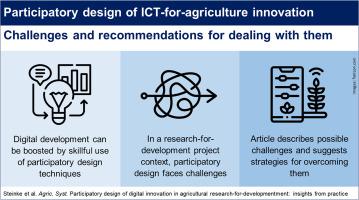Agricultural Systems ( IF 6.1 ) Pub Date : 2021-11-11 , DOI: 10.1016/j.agsy.2021.103313 Jonathan Steinke 1 , Berta Ortiz-Crespo 1 , Jacob van Etten 1 , Anna Müller 1

|
CONTEXT
Innovation based on information and communication technology (ICT) plays an increasingly important role in agricultural research-for-development efforts. It has been recognized, however, that the weak adoption and low impact of many ICT-for-agriculture (ICT4Ag) efforts are partly due to poor design. Often, design was driven more by technological feasibility than by a thorough analysis of the target group's needs and capacities. For more user-centered ICT4Ag development, there is now growing interest in the use of systematic, participatory design methodologies.
OBJECTIVE
Numerous methodologies for participatory design exist, but applying any of them in smallholder farming context can create specific challenges that digital development researchers need to deal with. This article aims to support future digital development efforts by contributing practical insights to recent discussions on the use of participatory design methodologies for ICT4Ag development.
METHODS
We present lessons learned from practical experiences within participatory design projects that developed ICT4Ag solutions in sub-Saharan Africa and Latin America. Based on these experiences and supported by literature, we describe common challenges and limitations that digital designers may face in practice, and discuss possible opportunities for dealing with them.
RESULTS AND CONCLUSIONS
The outcomes of digital design projects within research-for-development efforts can be affected by tensions between design ideals and project realities. These tensions may relate to, among others, mismatching expectations among project stakeholders, top-down hierarchies at design partners, insufficient attention to the wider digital ecosystem, and disincentives to re-use ideas and software. Depending on project context, these challenges may need to be addressed by researchers during planning and implementation of digital design projects.
SIGNIFICANCE
The insights in this article may support agricultural development researchers in facilitating more effective participatory design processes. Even though good design is not the only precondition for a successful ICT4Ag service, this can help create more meaningful digital innovation for agricultural development.
中文翻译:

农业研发中数字创新的参与式设计:来自实践的见解
语境
基于信息和通信技术 (ICT) 的创新在农业研发工作中发挥着越来越重要的作用。然而,人们已经认识到,许多 ICT 农业 (ICT4Ag) 工作的采用率低且影响低,部分原因是设计不当。通常,设计的驱动力更多是技术可行性,而不是对目标群体的需求和能力的彻底分析。对于更加以用户为中心的 ICT4Ag 开发,现在人们对使用系统化的参与式设计方法越来越感兴趣。
客观的
存在多种参与式设计方法,但将其中任何一种应用于小农农业环境都会带来数字发展研究人员需要应对的特定挑战。本文旨在通过为最近关于使用参与式设计方法进行 ICT4Ag 开发的讨论提供实用的见解来支持未来的数字开发工作。
方法
我们介绍了从在撒哈拉以南非洲和拉丁美洲开发 ICT4Ag 解决方案的参与式设计项目中的实践经验中汲取的经验教训。基于这些经验和文献支持,我们描述了数字设计师在实践中可能面临的常见挑战和限制,并讨论了应对它们的可能机会。
结果和结论
研发工作中数字设计项目的结果可能会受到设计理想和项目现实之间紧张关系的影响。这些紧张局势可能与项目利益相关者之间的期望不匹配、设计合作伙伴自上而下的等级制度、对更广泛的数字生态系统的关注不足以及对重用想法和软件的阻碍等有关。根据项目背景,研究人员可能需要在数字设计项目的规划和实施过程中解决这些挑战。
意义
本文中的见解可以支持农业发展研究人员促进更有效的参与式设计过程。尽管良好的设计不是成功的 ICT4Ag 服务的唯一先决条件,但这有助于为农业发展创造更有意义的数字创新。











































 京公网安备 11010802027423号
京公网安备 11010802027423号